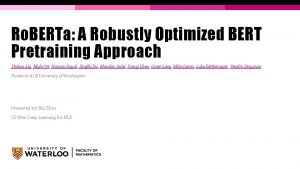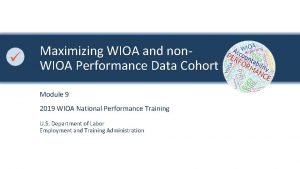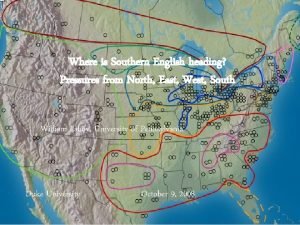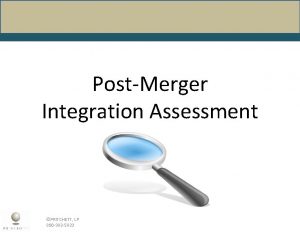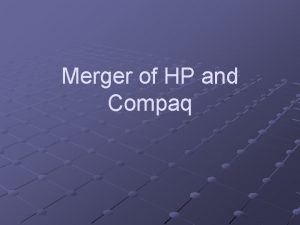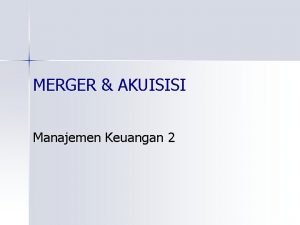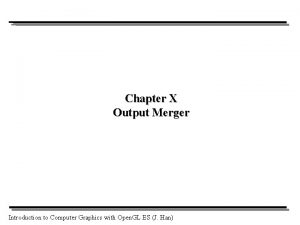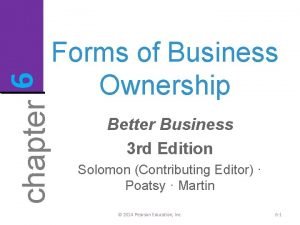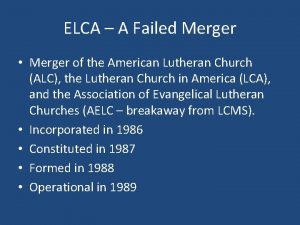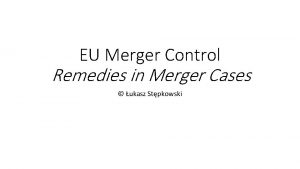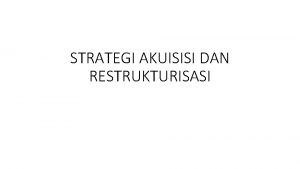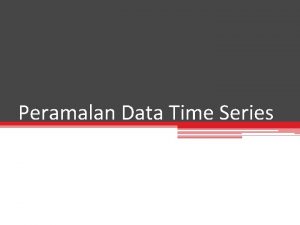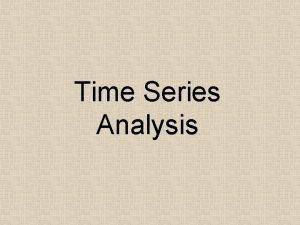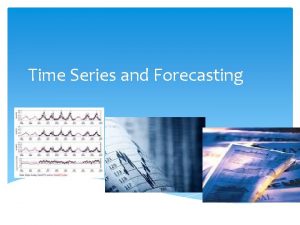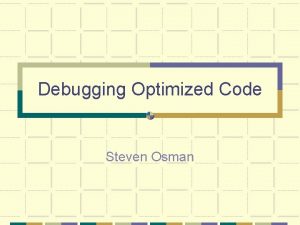Optimized multisatellite merger to create time series of

































- Slides: 33

Optimized multi-satellite merger to create time series of primary production in the California Current Mati Kahru 1 M. G. Jacox 2, R. M. Kudela 2, Z. Lee 3, and B. G. Mitchell 1 1 Scripps Institution of Oceanography, University of California San Diego, USA 2 University of California Santa Cruz, USA 3 University of Massachusetts, Boston Thanks to Cal. COFI, NASA OBP, CCE-LTER Liège Colloquium on Ocean Hydrodynamics, 2013/05/17

10/3/2020

• The Keeling curve is an example of climate data records (CDRs) • We need CDRs to evaluate long-term changes, e. g. in response to climate change • Satellite data cover wide space and time domains but individual satellite sensors have limited life span (6 months to ~13 years). • Problem 1: Need to merge data from multiple sensors but products from different sensors are not exactly compatible Sea. Wi. FS 10/3/2020 MODISA MERIS

Problem 2: Satellite products may be quite inaccurate. Most NPP models use Chl-a as main input representing phytoplankton biomass. Csat (satellite-derived surface Chl-a) is the primary output of OCR and is operationally derived using band-ratio algorithms which cannot separate Chl-a from CDOM and other absorbing components Other input large errors where CDOM is high or not tightly coupled to Chl-algorithm Rrs 1. 0 Log 10 ( Sat Chl-a) 0. 5 0. 0 10 X -0. 5 5 X -1. 0 2 X Sea. Wi. FS MODISA MERIS -1. 5 -0. 5 Log 10 (In situ Chl-a) Chl data from Ben Mustafa et al. , 2012 Chl NPP

• We need to abandon using band-ratio Chl-a estimates in NPP models, at least in the Arctic! • CDOM (and detritus) are erroneously counted as Chl-a but are not contributing to photosynthesis; they reduce light and the depth of the euphotic zone • We can use semianalytic algorithms (e. g. GSM, QAA, GIOP, etc) that separate individual components such as Chl-a or aph, adg , bbp but they are very sensitive to errors in satellite Rrs • Semianalytic models are typically built using ideal, i. e. simulated, or in situ Rrs • Real satellite Rrs are not ideal and have errors! 10/3/2020

Different sensors do not give the same Rrs! MERIS vs. MODISA, 2012, Level 3, 9 km pixels Rrs 412/Rrs 412 10/3/2020

Rrs 412/Rrs 412 1. 0 0. 8 MODISA/Sea. Wi. FS 0. 6 MERIS/Sea. Wi. FS 0. 4 MERIS/MODISA 0. 2 -2. 9 -2. 7 -2. 5 -2. 3 Log 10 (Rrs 412) -2. 1 -1. 9 Ratios of Rrs 412 values estimated by different sensors (median bracket points) of the satellite to satellite match-ups at daily Level 3 images over the year of 2004 for MODISA versus Sea. Wi. FS and MERIS versus Sea. Wi. FS and for year 2012 for MERIS versus MODISA. The heavy black line of Rrs 412/Rrs 412 = 1 corresponds to the ideal case of no inter-sensor bias. 10/3/2020

Chl-algorithm Rrs Chl NPP Rrs( ) ~ bb( ) / (a( ) + bb( )) aph Lee et al. , 1996; Marra et al. , 2003 Lee et al. , 2012 Chl-OC 4 Chl-QAA NPP-VGPM Aph-PP

In order to create satellite products that are compatible with in situ data and compatible between multiple sensors we have 2 tasks: 1. Minimize bias with in situ data 2. Minimize bias between the corresponding products of different sensors Ideally (Task 2) would follow from (Task 1) but in practice the distribution of in situ match-ups is inadequate in space, time, range and is therefore not sufficient to create convergence between products of different sensors. We have used the QAA algorithm (Lee et al. 2007) to tune the retrieval of spectral absorption and backscattering from multiple ocean color sensors (OCTS, Sea. Wi. FS, MODISA, MERIS, MODIST) using match-ups with in situ and between overlapping satellite Rrs. If satellite Rrs are consistently biased – no problem! 10/3/2020

Optimization of aph 440 retrievals from MODISA match-ups using QAA standard (left) and optimized model (right): R 2: 0. 78 ->0. 93, % difference: 89% -> 24%, bias: -40% -> 2% 10/3/2020

Combined (Sea. Wi. FS, MODISA, MERIS) aph 440 match-ups with in situ (top) and sat/sat (bottom) before (left) and after (right) optimization Task 1 Task 2 10/3/2020

10/3/2020

Estimated linear trend in the merged monthly anomalies of aph 440 (1996 -2012). The trend has been calculated for the ratio anomaly. 10/3/2020

California Cooperative Oceanic Fisheries Investigations (Cal. COFI) , 1949 -present, 60+ years Cal. COFI NPP measurements (1985 -2012). Typically 4 surveys annually, current total of 1857 PP casts until Feb-2012. Red markers denote stations that have match-ups with glider profiles.

We use the same optimization approach to create optimized NPP products for multiple sensors: by minimizing differences with in situ NPP (Task 1) and between sensors (Task 2). Using high-resolution Level-2 Rrs from multiple sensors: OCTS, 1996 -1997 Sea. Wi. FS, 1998 -2010 MODISA, 2002 -present MERIS, 2002 -2012 MODIST, 2000 -present VIIRS – to be added 10/3/2020

For each satellite match-up extract Rrs( ), … MERIS, MODIST, MODISA, Sea. Wi. FS Rrs QAA-Cal. Fit Lee et al. , 2002, 2007; Adapted in Kahru et al. , 2013 a( ), bb( ), aph( ), adg( ) Merged from MODIST, MODIA, Sea. Wi. FS a 490, aph 440, bbp 490 Lee et al. (2011) 10/3/2020 NPP PAR(0) Work in progress….

Sea. Wi. FS L 2 match-ups with NPP before (left) and after (right) optimization 10/3/2020

MERIS L 2 match-ups with NPP before (left) and after (right) optimization 10/3/2020

Sea. Wi. FS + MERIS + MODISA L 2 match-ups with NPP before (left) and after (right) optimization 10/3/2020

How does this compare to other NPP methods? Not much better! From Kahru et al (2009), smaller dataset, using only Sea. Wi. FS Algorithm ESQRT VGPM-KI Marra Cb. PM VGPM-CAL r 2 0. 553 0. 662 0. 620 0. 636 0. 389 0. 661 RMSDcp Slope Intercept 0. 242 0. 220 0. 461 1. 553 0. 269 0. 188 0. 662 1. 091 0. 248 0. 210 0. 439 1. 616 0. 207 0. 789 0. 503 0. 262 0. 260 0. 537 1. 286 0. 188 1. 0 0. 0 RMSD = total root mean square difference (log 10) RMSDcp = centered pattern RMSD, unbiased RMSD VGPM-CAL = B & F model fitted to Cal. COFI NPP data 10/3/2020

Jacox et al. (2013): Using vertical profiles of Chl and light improves model skill by much more than is possible from improved satellite surface estimates Improvement in predicting NPP: a) Sat Chl, SST b) in situ surface Chl 0 and SST (i. e. ideal satellite input) c) Chl vertical profile 10/3/2020 d) Chl and light profiles potentially measurable from gliders

Conclusions • We created optimized, multi-satellite algorithms for Chl-a, IOPs and NPP for the CC area that are (1) empirically tuned to in situ match-ups and (2) are consistent between multiple sensors • Vertical structure in Chl-a and light profiles is poorly estimated from surface ocean color measurements and limits the skill of satellite NPP models • This 16 -year time series is too short to separate interannual and multidecadal cycles from climate trends but the observed trends of lower productivity in the North Pacific gyre and higher productivity in the central California upwelling zone are consistent with the effects of climate change (16 years < ~ 40 years, S. Henson et al. ) Thank you!

10/3/2020

aph 440 trend (1996 -2012) Chl-a trend (1996 -2011) from Kahru et al, 2012

Rrs 443/Rrs 443 Rrs 490/Rrs 488 Different sensors do not give the same Rrs! Rrs 560/Rrs 547 10/3/2020 MERIS vs MODISA, 2012 Rrs 670/Rrs 667

Refined Csat/Cins match-ups. Dotted lines: 1: 1, 2 x, 3 x and 5 x.

Standard band-ratio Chl-algorithms are inaccurate even in typical Case 1 waters, such as California Current: underestimation at high Chl median “brackets” of Chl versus sat MBR. Blue curves = OC 3/OC 4 Red curves = best fit Kahru et al. , DSR, 2012,

Optimization of aph 440 and adg 440 retrievals from OCTS match-ups using standard QAA (left) and optimized model (right) No radiometric closure between satellite Rrs(λ) and in situ IOPs satellite retrievals are forced to in situ measurements by optimization of the model coefficients so that have no mean bias in the loglog space. Optimal coefficients are found by the Trust-Region method, a variant of the Levenberg. Marquardt method. 10/3/2020

Combined (OCTS, Sea. Wi. FS, MODISA, MERIS) adg 440 match-ups with in situ (top) and sat/sat (bottom) before (left) and after (right) optimization 10/3/2020

bbp 490 and aph 440 retrievals from MERIS match-ups using standard QAA (left) and optimized model (right) 10/3/2020

bbp 490 and aph 440 retrievals from MODISA match-ups using standard QAA (left) and optimized model (right) 10/3/2020

Estimated trend in the multi-sensor (OCTS, Sea. Wi. FS, MODISA, MERIS) merged Chl-a (1996 -2011). Kahru M. et al. Trends in the surface chlorophyll of the California Current: Merging data from multiple ocean color satellites, Deep-Sea Research II, 2012

Trends in SST fronts FFsst (29 years, 1981 -2009) and Chl fronts FFchl (14 years, 1996 -2010)
 Roberta: a robustly optimized bert pretraining approach
Roberta: a robustly optimized bert pretraining approach Wioa optimized system
Wioa optimized system Jika noel(create(q)) adalah 0 maka front(create(q)) adalah
Jika noel(create(q)) adalah 0 maka front(create(q)) adalah Falling action of mulan
Falling action of mulan What is elapsed time
What is elapsed time Maclaurin series vs taylor series
Maclaurin series vs taylor series Heisenberg 1925 paper
Heisenberg 1925 paper Serie de taylor
Serie de taylor Maclaurin series vs taylor series
Maclaurin series vs taylor series Ibm p series models
Ibm p series models Amount of feedback
Amount of feedback Series aiding and series opposing
Series aiding and series opposing Arithmetic sequence sum formula
Arithmetic sequence sum formula When did singapore merge with malaysia
When did singapore merge with malaysia Pin-pen merger map
Pin-pen merger map West sussex ccg merger
West sussex ccg merger Reverse triangular merger
Reverse triangular merger Pritchett merger integration
Pritchett merger integration Post merger integration training
Post merger integration training Example of vertical mergers
Example of vertical mergers Jim harris compaq
Jim harris compaq Vertical merger example
Vertical merger example Latar belakang penggabungan usaha
Latar belakang penggabungan usaha Merger and acquisition
Merger and acquisition Reverse triangular merger
Reverse triangular merger Daimler-chrysler merger analysis
Daimler-chrysler merger analysis Xoutput
Xoutput What is merger and consolidation
What is merger and consolidation Centurylink qwest merger
Centurylink qwest merger Amazon and whole foods merger case study
Amazon and whole foods merger case study Disadvantage of mergers are
Disadvantage of mergers are Perbedaan akuisisi dan merger
Perbedaan akuisisi dan merger Merger and acquisition template
Merger and acquisition template Joint venture and merger example
Joint venture and merger example
